What would your future-you have to say to you?
The no-pants guide to spending, saving, and thriving in the real world.
What would your future-you have to say to you?
Welcome to the Totally Money Carnival #5, the Superbowl Edition. It’s my privilege to be the first outside host for this carnival.
I don’t watch the Superbowl. I’ve never been into spectator sports unless I have some skin in the game. If I’m playing, or have some money riding on the outcome, I’m watching. Other than that, I’ll usually pass. Yesterday, a bunch of grown men in tights earning envy-inducing amounts of money ran around for a few hours in front of people, some of whom paid 5 figures for the privilege of watching. Yay!
http://www.youtube.com/watch?v=hpjaOUjUPUc
Mike Piper presents Protecting Your Private Files posted at Oblivious Investor, “How can you keep your sensitive documents (scanned tax returns, for instance) both backed up and protected in the event of computer theft?” Ed. I love this solution, and I use it. All of my tax returns, online receipts, and documents I don’t want to lose get treated this way.
Suzanne K. presents The Psychology of Why You Can’t Budget—And Five Tips to Help You Do It posted at PsychologyDegree.net. Ed. I’ve always been a fan of trying to understand what makes people tick.
Silicon Valley Blogger presents Prepare Your Tax Return: Tax Products vs Tax Pros posted at The Digerati Life, saying “If you don’t enjoy preparing your taxes, you’re not alone. There are various ways to get your tax returns done. How do you go about preparing your taxes: DIY or with the help of a pro?” Ed. Tax time sucks. If we abolished payroll deductions and made everybody in the country write a check to the IRS every year, there would be a revolt on the next April 15th.
Kevin McKee presents How To Know if Your Job is Expendable posted at Thousandaire, saying “When businesses start doing poorly, some people are at risk of losing their job, while others are safe. Find out which category you fall in with these simple questions.” Ed: I was given a demonstration that defines expendability in the workplace. Fill a glass with water and place it on the counter in front of you. Stick your finger in the glass. Now, pull it out. See the impression you’ve made? I’ve done the rockstar bit, and I’ve been in positions that were necessary for the profitability of larger divisions of large companies. It doesn’t matter. Corporate loyalty is a joke.
35% of people who attend the game write it off as a corporate expense. (source)
Miss T presents 5 Ways to Lower Your Monthly Bills | Prairie EcoThrifter.com posted at Prairie Eco-Thrifter, saying “Believe it or not, there are lots of ways to save money, no matter how much of it you have- or don’t have.”
http://www.youtube.com/watch?v=jRYLhkOV2so
Tim Chen presents Pentagon Federal Offers Best Gas & Airfare Credit Card Rewards, Period. posted at NerdWallet Blog – Credit Card Watch, saying “There is only one credit card in America that offers no strings attached 5% cash back at any gas stations (excluding the likes of Costco) – the Pentagon Federal Platinum CashBack. It also gets you 2% back at grocery stores.”
Miranda presents Accelerate Your Credit Card Debt Pay Down posted at CreditScore.net, saying “Use these techniques to pay down your credit card debt faster.”
Buck Inspire presents Moving Up and On From Prepaid Debit Cards posted at Buck Inspire.
Ryan Hudson presents How I Got a Credit Card Late Fee Waived posted at Best Credit Cards IQ, saying “Don’t take accidental late fees laying down. Do something about it. Here’s how I got rid of my late fee.”
No network footage exists of Super Bowl I. It was taped over, supposedly for a soap opera.(source)
John presents Get Out of Debt Fast – How to Speed Up the Process posted at Passive Family Income, saying “There are quite a few people today that are beginning to dig their way out of debt. They have monitored their spending, created a budget, and have done the best that they can to stick with it. But, as many of you have experienced, the excitement of becoming debt-free gets pretty old after a while.”
http://www.youtube.com/watch?v=VRDx18GYITw
Mike Collins presents Defined Benefit vs Defined Contribution posted at Saving Money Today, saying “Understanding the different types of retirement plans.”
Boomer presents 10 Ways For Women To Obtain Financial Empowerment posted at Boomer & Echo, “It’s not that difficult to get your financial life under control (your control). Remember, a man is not a financial plan.”
The Super Bowl is measured in Roman numerals because a football season runs the span over two calendar years. This year the season began in 2010 and ends in 2011. (source)
Madison DuPaix presents Substitute, Improvise, and Make Do With What You Have posted at My Dollar Plan, saying “So often, when we run out of things we need, we run to buy something or spend money when we don’t have to. Find out how you can avoid this trap.”
Money Beagle presents The Power Of The Free Calendar posted at Money Beagle.
Amanda L Grossman presents Homemade Diversion Safes: Save Money by Making Your Own posted at Frugal Confessions – Frugal Living, saying “You can purchase your own home security money safes (diversion safes), but I thought it would be more frugal and fun to think of ones to make on your own. See what I can do with a used deodorant!”
http://www.youtube.com/watch?v=KQkK1UCH1EU
MoneyNing presents What Would You Do with a Million Dollars? posted at Money Ning, saying “I know what I would do with a million dollars. How about you?”
More drivers are involved in alcohol-related accidents on Super Bowl Sunday than any other day of the year (except St. Patrick’s Day), according to the Insurance Information Institute. (source)
Joe Morgan presents Is Gen Y Irresponsible, Or Is It A Matter Of Perspective? posted at Simple Debt-Free Finance, saying “Generation Y has a reputation for having a sense of entitlement, but here’s one reason it may just be a matter or perspective.”
http://www.youtube.com/watch?v=_78ylMLa0JQ
Ryan @ MFN presents Roth IRA Qualifications posted at The Military Wallet, saying “Are you qualified to open a Roth IRA? Find out income and contribution requirements to see if you are eligible!”
Brian @ BeBetterNow presents Money’s Golden Rule: Spend Less Than You Earn posted at Be Better Now, “In the end, most personal finance advice boils down to spending less than you earn. Here’s another article to reinforce that.”
http://www.youtube.com/watch?v=g364TG_8Qmw
Barb Friedberg presents Wealth in Life: 25 Cheap Ideas for Fun posted at Barbara Friedberg Personal Finance, “Join in to build a massive list of low cost fun!”
http://www.youtube.com/watch?v=R55e-uHQna0
PT presents Tax on Unemployment Compensation posted at PT Money, saying “A detailed look at what taxes are due on your unemployment compensation.”
Ken presents Important Tax Update for 2010 You Don’t Want To Miss posted at Spruce Up Your Finances, saying “A few of the tax provisions applicable to tax year 2010 such as the extension of tax filing date, expanded tax benefits, phase out on some limitations, etc.”
Fanny presents Top 10 Tax Deductions for Parents posted at Living Richly on a Budget, “Being a parent is one of the most important roles in life. Why not take advantage of all the deductions you qualify for?”
Thank you all for participating! Next week’s host is Saving Money Today, so be sure to submit your posts.
Saving is hard. For years, we would either not save at all, or we’d save a bit, then rush to spend it. That didn’t get us very far. Years of pretending to save like this left us with nothing in reserve. Finally, we’ve figured out the strategy to save money.
First and foremost, make more than you spend. This holds true at any level of income. If you don’t make much money, then you need to not spend much, either. Sometimes, this isn’t possible under current circumstances. In those cases, you need to either increase your income or decrease your expenses. Cut the luxuries and pick up a side hustle. The wider the gap between your bottom line and your top line, the easier it is to save.
Next, make a budget and stick to it. There is no better way to track both your income and your expenses. I’ve discussed budgets before, so I won’t address that in detail today. Short version: Make a budget. Use any software you like. Use paper if you want. Make it and use it.
Pay yourself first. The first expense listed on your budget should be you. Save first. If you can’t afford to save, you can’t afford some of the other items in your budget. Cut the cable or take the bus, but save your money. Without an emergency fund, your budget is just a empty dream when something unexpected comes up. And something unexpected always comes up.
Automate that payment to yourself. Don’t leave yourself any excuse not to make that payment. Set up an automated transfer to another bank and forget about it. Schedule the transfer to happen on payday, every payday.
Now comes the hard part: Forget about the money. Don’t check your balance. Don’t think about it in any way. Just ignore it. For the first month or two, this will be difficult. After that, you’ll forget it exists for a few months and come back amazed at how much you’ve saved.
If you don’t forget about it, and you decide to dip into the account, you are undoing everything you’ve worked so hard to save. Do yourself a favor and leave the money alone.
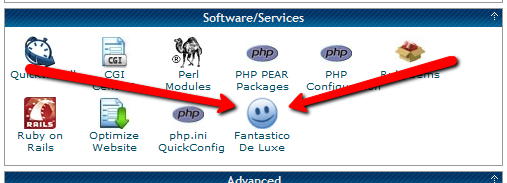
In this installment of the Make Extra Money series, I’m going to show you how to set up a WordPress site. I’m going to show you exactly what settings, plugins, and themes I use. I’m not going to get into writing posts today. That will be next time.
I use WordPress because it makes it easy to develop good-looking sites quickly. You don’t have to know html or any programming. I will be walking through the exact process using Hostgator, but most hosting plans use CPanel, so the instructions will be close. If not, just follow WordPress’s 5 minute installation guide.
Assuming you can follow along with me, log in to your hosting account and find the section of your control panel labeled “Software/Service”. Click “Fantastico De Luxe”.

On the Fantastico screen, click WordPress, then “New Installation”.
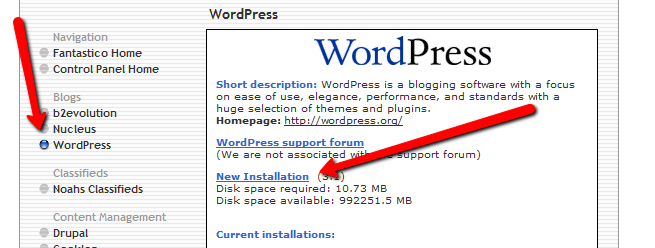
On the next screen, select your domain name, then enter all of the details: admin username, password, site name, and site description. If you’ll remember, I bought the domain http://www.masterweddingplanning.net. I chose the site name of “Master Wedding Planning” and a description of “Everything You Need to Know to Plan Your Wedding”.
Click “install”, then “finish installation”. The final screen will contain a link to the admin page, in this case, masterweddingplanning.net/wp-admin. Go there and log in.
After you log in, if there is a message at the top of the screen telling you to update, do so. Keeping your site updated is the best way to avoid getting hacked. Click “Please update now” then “Update automatically”. Don’t worry about backing up, yet. We haven’t done anything worth saving.
Next, click “Settings” on the left. Under General Settings, put the www in the WordPress and site URLs. Click save, then log back in.
Click Posts, then Categories. Under “Add New Category”, create one called “Misc” and click save.
Click Appearance. This brings you to the themes page. Click “Install Themes” and search for one you like. I normally use Headway, but before I bought that, I used SimpleX almost exclusively. Your goal is to have a simple theme that’s easy to maintain and easy to read. Bells and whistles are a distraction.
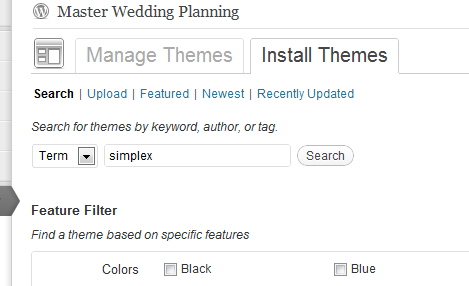
Click “Install”, “Install now”, and “Activate”. You now have a very basic WordPress site.
A plugin is an independent piece of software to make independent bits of WordPress magic happen. To install the perfect set of plugins, click Plugins on the left. Delete “Hello Dolly”, then click “Add new”.
In the search box, enter “plugin central” and click “Search plugins”. Plugin Central should be the first plugin in the list, so click “install”, then “ok”, then “activate plugin”. Congratulations, you’ve just installed your first plugin.
Now, on the left, you’ll see “Plugin Central” under Plugins. Click it. In the Easy Plugin Installation box, copy and paste the following:
All in One SEO Pack Contact Form 7 WordPress Database Backup SEO SearchTerms Tagging 2 WP Super Cache Conditional CAPTCHA for WordPress date exclusion seo WP Policies Pretty Link Lite google xml sitemaps Jetpack by WordPress.com
Click “install”.
On the left, click “Installed Plugins”. On the next screen, click the box next to “Plugins”, then select “Activate” from the dropdown and click apply.
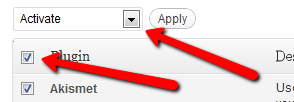
Still under Plugins, click “Akismet Configuration”. Enter your API key and hit “update options”. You probably don’t have one, so click “get your key”.
The only tool I worry about is the backup. It’s super-easy to set up. Click “Tools”, then “Backup”. 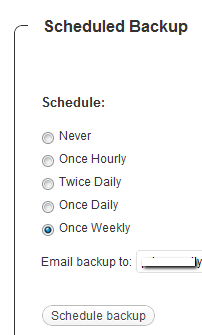
Scroll down to “Schedule Backups”, select weekly, make sure it’s set to a good email address and click “Schedule Backup”. I only save weekly because we won’t be adding daily content. Weekly is safe enough, without filling up your email inbox.
There are a lot of settings we’re going to set. This is going to make the site more usable and help the search engines find your site. We’re going to go right down the list. If you see a section that I don’t mention, it’s because the defaults are good enough.
Set the Default Post Category to “Misc”.
Visit this page and copy the entire list into “Update Service” box. This will make the site ping a few dozen services every time you publish a post. It’s a fast way to get each post indexed by Google.
Click “Save Changes”.
Uncheck everything under “Email me whenever…” and hit save. This lets people submit comments, without actually posting the comments or emailing me when they do so. Every once in a while, I go manually approve the comments, but I don’t make it a priority.
Select “Custom structure” and enter this: /%postname%/
Click save.
Set the status to “Enabled”, then fill out the site title and description. Keep the description to about 160 characters. This is what builds the blurb that shows up by the link when you site shows up in Google’s results.
Check the boxes for “Use categories for META keywords” and “Use noindex for tag archives”.
Click “Update Options”.
Check the boxes to remove each of the dates and set the alt text to “purpose” or something. This will suppress the date so your posts won’t look obsolete.
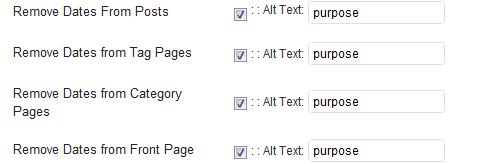
This plugin reinforces the searches that bring people to your site. It’s kind of neat. Skip the registration, accept the defaults and hit save.
Scroll to the bottom and click import. We’ll come back to this.
Select “Caching On” and hit save.
Across the top of the screen should be a giant banner telling you to connect to WordPress.com and set up Jetpack. You’ll need an account on WordPress.com, so go there and set one up. After authorizing the site, you’ll be brought back to the Jetpack configuration screen. Click “Configure” under “WordPress.com Stats”. Take the defaults and hit save.
On the contact configuration page, copy the code in the top section. You’ll need this in a moment.
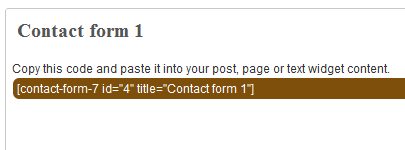
Now, we going to create a couple of static pages. On the left, click “Pages”, then “Add new”.
Name the first page “Contact” and put the contact form code in the body of the page. Hit publish.
Under Appearance, click “Menu”. Enter a menu name and hit save.
Then, under “Pages”, click the box next to “Contact”, “Disclaimer”, and any other policies you’d like to display. Hit save.
Also under Appearance, click “Widgets”. This is where you’ll select what will display in the sidebar. All you have to do is drag the boxes you want from the middle of the page to the widget bar on the right. I recommend Text, Search, Recent Posts, Popular Search Terms and Tag Cloud. In the text box, just put some placeholder text in it, like “Product will go here”. We’ll address this next time.
We’re not going to worry about getting posts in place, yet. That will be the next installment. However, the steps in the next installment could take 2 weeks to implement, and we want Google to start paying attention now. To make that happen, we need to get a little bit of content in place. This won’t be permanent content. It’s only there so Google has something to see when it comes crawling.
To get this temporary, yet legal content, I use eZineArticles. Just go search for something in your niche that doesn’t look too spammy.
Then, click “Posts”, then delete the “Hello World” post. Click “Add new”. Copy the eZine article, being sure to include the author box at the bottom, and hit publish.
To see your changes, you may have to go to Settings, then WP Cache and delete the cache so your site will refresh.
Congratulations! You now have a niche blog with content. It’s not ready to make you any money, yet, but it is ready for Google to start paying attention. In the next installment, I’ll show you how I get real unique content and set it up so Google keeps coming back to show me the love.
This is a guest post written by Andreas Nicolaides, a financial author for UK based MoneySupermarket.com.
Whether your aim is to save money for a special occasion or you just want to make sure you don’t have to struggle financially when it comes to the end of the month, a budget can be a saving grace. Budgets help us quickly and easily identify our total income and all our expenditure, allowing us to plan for the best and prepare for the worst financial situations.
Set yourself a target
If you have decided to set up a budget, then there must be a reason. Are you looking to save for an upcoming event? Or maybe you have realised that you are struggling to make your payments every month and you would like to feel more financially secure. Based on what you would like to get out of your budget, you should set yourself a specific, measurable objective.
My first objective I set for myself was to save $100 every month for a year. This sort of objective is easy to manage and easy to monitor and this is what we are trying to achieve. One important thing I would mention here is to ensure your objective is achievable; don’t set yourself a target that is too far out of your reach, being realistic is extremely important.
How do you set up your budget?
The main key thing when you start to put your budget together is to make sure you’re as honest as possible. Get yourself a pen and some paper and on one page detail all of your income. Include the obvious and also remember to include any benefits you are entitled too. Then grab another piece of paper and detail all of your monthly outgoings, remember to be honest and thorough and try not to forget anything. Once you have both figures, deduct your expenditure from your monthly income that will give you your monthly figure.
You have some extra cash?
If when you have your figure you realise that there is some cash left over, you can then decide what you want to do with it. My advice here depends on your own personal circumstances, for example if you have high levels of debt, your main aim should be tackle your high interest debt aggressively and as often as possible.
If you have some money left over and your aim is to save, then set up an interest bearing bank account. If you are based in the US then you could look to set up an LSA or lifetime savers account. In the UK we have the equivalent, that is called a cash ISA saving account.
No money left over?
If after working out your budget you find you have no money left over, then you need to do something about it. Debt is one of those things that won’t just disappear overnight; it’s something that takes time and commitment, but not giving up is paramount.
How to cut down your expenditures?
One of the main things you can do when you realise you are in a bad situation is to try and cut down on your expenditure. Here’s a couple of quick ways:
A budget is used by many just to monitor what they spend month to month, but I hope I have detailed how it can be a helpful financial tool that can help you reach your financial goals. I hope my tips to budget successfully will help you get started on your way to financial freedom.
Frugal cooking can be an intimidating concept. It’s easy to turn a meal into a huge expense, but it’s not that hard to trim your grocery budget without sacrificing variety and flavor. It just takes some planning and a few money-saving techniques. We usually feed our family of five, often with guests, for about $100 per week.
Schedule your meals. Find or make a weekly meal planner. I recommend this or this. Cross out the meals you don’t need to worry about due to your schedule that week. If you won’t be home, you don’t have to cook that meal. Fill in the meals in the remaining slots. Keep your schedule in mind. If you get home from work at 5:30 and have to be somewhere by 6:30, dinner needs to be something quick. Also, make sure you include every side dish you will be serving. Now, look at the recipe for each dish in every meal. Write down everything you need to make all of the food you plan to eat that week. While planning your meals, think about how to use your leftovers. If you cook chicken breasts one day, the leftovers can be chicken nuggets the next.
Take inventory. Take your meal plan and a pen while you look through all of your cabinets and your refrigerator. Why buy what you already have? If you already have steaks in the freezer, don’t waste your money buying more. If you have it, cross it off of your meal plan shopping list. Whatever is left is your shopping list. Review it. Is there anything that can be combined or eliminated? Is there a key ingredient for a sauce that’s missing?
Don’t forget the staples. If flour or sugar is on sale, stock up. Anything you use on a regular basis is a staple, buy it when it’s cheap.
Build a shopping list from your meal plan. When you are in the store, stick to your list. It’s hard, but avoid impulse purchases at all costs. Don’t shop hungry, don’t buy things just because they are on sale, and don’t dawdle. Get what you need and get out.
Avoid pre-processed food. We slice and shred our own cheese. Buying the pre-shredded cheese costs an extra $5 and saves just 5 minutes. Don’t buy pre-sliced apples or anything that will only save a few minutes for several dollars of cost.
Every couple of weeks, I cook a large pot of either beans or rice and keep it in the refrigerator. Almost every meal that we cook gets a cup or two of beans or rice added to it. It doesn’t alter the flavor much, but it adds a few extra servings for pennies. It’s a healthy way to stretch any meal on the cheap.
We have a large bowl in the refrigerator filled with mixed greens. We buy whatever salad-like greens are on sale and prepare the large salad all at once. Most meals start with a salad, which makes it easier to fill up without relying on the protein dish, which is generally the most expensive part of a meal. As a dedicated meat-eater, it took some getting used to, but it’s a good meal–cheap and healthy.
Cook enough for at least 3 meals. That will eliminate 2/3 of the work involved in cooking. Plan ahead to make your meals simple and easy.
Freeze the leftovers in usable sizes. Stock up on semi-disposable meal-sized containers. Freeze some in single-serving sizes for work, and others in family-size servings for last minute meals at home. Preparing for last minute meals keeps you from serving garbage or takeout when life gets in the way of your plans.
Avoid wasting leftovers. Wasted food is wasted money.
When you are done cooking meat, take any drippings or scraps and throw them into the slow-cooker along with any vegetable scraps laying around. Cook it overnight, then strain it into an ice cube tray. You now have stock/broth ready to be added to any recipe.
Plan for serial meals. Chicken breast leftover from today’s meal can become chicken nuggets tomorrow, to be shredded into chicken salad the next day.
When there isn’t enough left for a full serving, we put the remains in a resealable bag in the freezer. When we accumulate enough to fill our slow-cooker, we dump in all of the bags with a couple cups of water. I look through the refrigerator for any leftovers that have been overlooked that week or any vegetables getting close to being too old. It all gets cut up and added to the cooker to cook on low all day. I rarely add seasoning because everything going in the pot tastes good. We never get the same meal twice and our “free soup” is never bland.
That’s how we cook cheap, without sacrificing too much time. How do you save money cooking?
This post is a blast from the past. Originally posted here in January 2010.